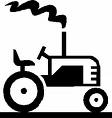 Farm tractors provide
the primary source of power on many farms. Studies show that the farm
tractor is involved in a high proportion of farm fatalities and severe
injuries. To avoid them, follow safe management principles and implement
a tractor safety program on your farm.
- Develop a "safety first" attitude. Follow safe work practices
all the time and set a good example for others.
- Be physically and mentally fit when operating tractors. Fatigue,
stress, medication, alcohol and drugs can detract from safe tractor
operation. Take breaks.
- Read operator's manual and warning decals. Pay attention to
safety information.
- Equip the tractor with a Rollover Protective Structure (ROPS)
and wear seat belts.
- Inspect the tractor for any hazards and correct them before
operating.
- Make sure everyone who operates a tractor has received training
and is physically able to operate it safely.
- Shut down equipment, turn off engine, remove key and wait for
moving parts to stop before dismounting equipment.
- Keep bystanders and others away from tractor operation area. Do
not allow "extra riders," especially children.
|